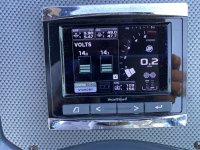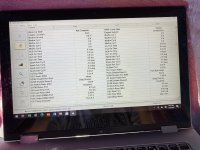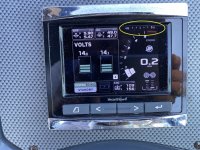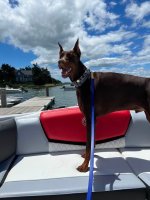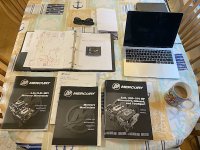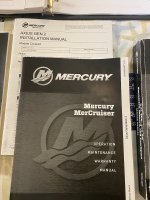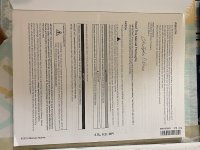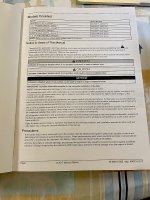All models need a minimum of 800 CCA, 1000 MCA, 180 Ah batteries.
IMPORTANT: For DTS products, each engine must be equipped with its own starting battery. If your boat application requires additional battery loads for boat accessories or marine electronics, it is recommended that an auxiliary battery or batteries be installed.
Multiple MPI Engine Battery Information Batteries: Boats with multi‑engine MPI power packages require each engine be connected to its own battery. This ensures that the engine's Electronic Control Module (ECM) has a stable voltage source. Battery switches: Battery switches should always be positioned so each engine is operating off its own battery. Do not operate engines with switches in BOTH or ALL position. In an emergency, another engine's battery can be used to start an engine with a dead battery. Battery isolators: Isolators can be used to charge an auxiliary battery used for powering accessories in the boat. They should not be used to charge the battery of another engine in the boat unless the type of isolator is specifically designed for this purpose. NOTE: Sure Power Industries Inc., Model 32023A meets this design specification. 1. The boat may have 2 engines connected to a single Model 32023A battery isolator. 2. The Model 32023A battery isolator is connected to 2 banks of batteries. 3. Each bank contains 2 batteries with the cranking battery for 1 engine in each bank. 4. The second battery in each bank is connected in parallel to the cranking battery. 5. The Model 32023A battery isolator is designed for this type of use; 2 battery banks, 2 charging sources, 120 amps (maximum alternator output). 6. When the engines are operating, either engine's alternator could be charging either bank of batteries through the Model 32023A battery isolator. Any other manufacturer's battery isolator that is the same type as the Sure Power Inc., Model 32023A could also be used. Generators: The generator's battery should be considered another engine's battery.
Helm main power relay (MPR) harness connection—This harness connects the helm harness to the circuit protected switched starboard battery power, only used on the starboard side. The helm MPR harness supplies this heavy power to the starboard helm CCM main power relay. This power is primarily used for steering wheel centering. This harness connects to a fused power and ground supplied by the boat builder. Does the Cruisers wiring diagram show this connection at the helm? Sometimes the boat builder will use the house battery for this and that can lead to the problems you’re experiencing.
From the install manual,
Main Power Relay (MPR) Harness Connections for Mercury Propulsion System Components
1. Positive
a. Standard positive connection: Install a 20‑amp circuit breaker or 20‑amp ATC fuse for the positive circuit of the main power relay harness on the switched side of the appropriate engine cranking battery system.
b. Optional positive connection: The main power relay (MPR) harness does not have circuit protection or wire terminals on the end of the harness that connects to the power source. Therefore, the builder must provide an in‑line circuit breaker or fuse and the necessary wire terminals to connect the harness to the DC power bus.
NOTE: Refer to the main power relay harness instruction sheet for recommended connection points.
2. Ground
a. Standard ground connection: Connection of any required MPR grounds should be made directly to the negative post of the associated system’s cranking battery.
b. Optional ground connection: Connect the ground directly to the main vessel DC ground bus. The main ground bus must be part of the engine cranking ground path. The connection should be connected directly to the bus and should carry no other loads between it and the cranking ground bus connection.
IMPORTANT: Connection to auxiliary vessel ground paths not carrying cranking ground current is specifically not allowed.
Some questions about your boat.
This is part of what my problem is.
For diagnostic troubleshooting and parts identification, it is often necessary to determine which version of Axius is present on the boat. Axius Gen 1 and Gen 2 may be easily discerned by their hardware and physical differences. However, Axius Gen 2 and Axius Joystick Piloting for Sterndrives (JPS) look physically identical and may only be identified by their engine serial numbers. CDS G3 can be used to positively identify all versions of Axius by the matching eBOM.I’m not able to I.D. your system by the serial number and G3 isn’t a option. So I’ll ask these question.
From reading your posts, it appears that you have electronic steering, electronic throttles, vesselview4 and joystick. Is this correct?
Can you post a picture of your throttle and shifters?
Do you have a trackpad that allows you to engage features like, Skyhook, Waypoint Sequencing, Auto Heading, Troll, Engine Synchronization, Docking Mode, Throttle Only and Single‑Lever Mode? Do you have any of these features and how do you access them?
Do you know if you have Axius Joystick Piloting basic or Axius Joystick Piloting premier?
Do you have “multiwake”? This is a feature that among other things sends power to both engine gauge packages when just one of the keys is turned on.
Do you have a Fire Suppression system that shuts down the engines if the halon bottle goes off?
Do you have a start/stop panel with push buttons or just key switchs?
What style of Lanyard Stop switch installed? Maybe post a picture?
What is the part number of the PCM 112 diagnostic manual you have?
Sorry for all these questions but with me not being on the boat I just don’t know. These are all questions that a trained tech sees when they climb aboard.
If you start messing around under the dash, know that all the really important connectors (steering, throttles and shift) will have a feature known as connector position assurance (CPA) clip. Make sure you disengage this clip before separating the connectors and you won’t be able to engage the clip until both connectors are fully together. Be careful when checking this stuff. Your computers stay “awake” for a few minutes after you turn the keys to off and can stay awake after the battery switches are turned off. This is because the clean power is on all the time. So unless you know what fuses to pull, it’s best to disconnect ALL the batteries ground cables otherwise it’s possible to fry a computer and you have more than a few on this boat! Also be careful when probing the connecters, there is a set of special probes we use to keep from deforming all these connectors.
Do NOT connect multiple batteries together, if you suspect an issue with batteries. Load test them or replace them. Never run the boat with the switches set to all.
Clean Power Connections for DTS and ECT engines
Mercury clean power harnessing must be connected directly to the positive and negative posts of the corresponding propulsion engine's cranking battery.
IMPORTANT: Any deviations from the clean power connection requirement must be approved by Mercury Marine.
I’m not sure if I was clear about clean power, this is a separate power connection to the engine battery. As outlined above it is a 2 wire harness with a inline fuse (can be 5amp, 7amp or 20amp depending on what systems are installed) near the battery that connects to the engine near the power post that the big battery cable connects to with a 2 wire connecter. It also might be near the back of the engine by the 14 pin can connection and the transom harness connector.
Answers to some of your questions, let me know if I missed any or you would like a better explanation.
G3 is the only tool that can see all the different components of this system. But it’s only available to Mercury Marine dealers. ---- It’s hard for me to not get started on “Right to Repair’ legislation. I just ask that we DIY people keep this in mind when voting for the people who make the laws! ---- sorry but some things bother me. That said Diacom is what you have and it’s the best substitute for G3 that’s available. Just remember that there are something’s it can’t do.
You are seeing different data streams. Your engine has 2 connection points on the engine. The one to the right of the main circuit breaker is the J1939 diagnostic connection. The one to the left of the circuit breaker is the 10‑pin diagnostics can bus connector like the one at the helm.
Wow that’s a lot of info and I’ve run out of time for this post, I’m going to have to post it without proof reading. Let me know if there are any mistakes or questions.




















